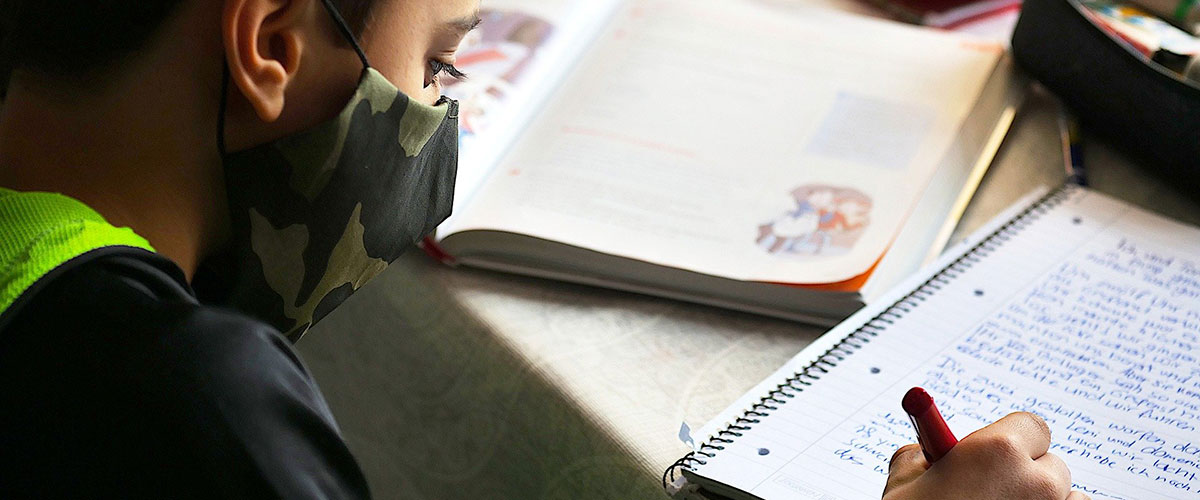
In March, we went to London to visit two research schools and our colleagues from the Education Endowment Foundation. It was 2 days full of inspiration and wise lessons.
Jan 25, 2021
By

Since 16 December 2020, the Netherlands has been in a hard lockdown. As was the case in March 2020, all schools have had to close their doors; this means that for the vast majority of pupils, schools are physically closed until at least 17 January 2021.
The provision of education at a distance has therefore become unavoidable. Education Lab NL and the Education Inspectorate have investigated which promising interventions can help with distance learning. For this purpose, we conducted a literature study of overview studies and a series of separate scientific studies. We focused on hard and convincing evidence, i.e. we limited ourselves to studies that met the very highest scientific standards.
Our research shows that with good distance learning and additional measures at the school level, it is possible to provide effective distance learning. Based on various studies, we conclude that there are four things that are important in distance learning.
(1) Quality of teaching is essential. The quality of teaching is even more important in an online lesson than in a face-to-face lesson. As with physical lessons, good didactics consist of a combination of giving clear explanations that match the knowledge and skills level of the pupils, organising structure, clarity and calm, involving the pupils in the teaching, offering exercises and giving feedback.1 It is particularly important that these elements of effective teaching are present, and less important how or when the lessons are given.
(2) Organise interactions between learners. These interactions can take place during the digital lessons or outside of them. When the interaction is used during the lesson, it has the greatest effect on learning performance and motivation when it is purposefully designed and implemented by the teacher. Communication and collaboration applications can promote student-teacher interaction4 such as Slack, Google Drive and TEAMS.
(3) Allow pupils to work independently. More than physical classes, distance learning relies on the learners’ ability to structure themselves and to use appropriate learning strategies. As a teacher you can help by simplifying tasks, breaking them down into subtasks or adapting them so that they require less complex actions, knowledge and tools. In addition, you can offer certain learning strategies that allow students to continue working on the task, such as having students explain the material to a housemate or creating a mind-map that helps students organise certain concepts or ideas.
(4) Extra attention for vulnerable pupils. Pupils with learning difficulties perform particularly poorly in the online environment. It is important that teachers pay extra attention to the needs of these pupils and the ways in which they can keep them involved in their teaching. Examples include the proper recording and monitoring of cognitive results and social-emotional wellbeing. But also maintaining more intensive contact with these pupils during or outside the lessons or providing more support with independent working, for example by providing checklists.
Furthermore, we conclude that the following five additional measures at school level are important:
(1) Organise access to distance learning for all pupils. Access to digital resources is a hard precondition for distance learning; without a laptop or internet it is usually impossible to follow digital lessons. Schools and training institutions should therefore ensure that all pupils have a laptop/tablet, internet and access to digital learning resources.
(2) Help teachers become better at distance learning. Teacher professionalisation is one of the most effective interventions in education in both the short and long term. This includes extra guidance and support in the use of new hardware and software applications (such as TEAMS, Google classrooms, etc.), and the combination of physical and distance learning.
(3) Monitor the well-being of pupils, teachers and school leaders. School leaders and teachers face extra challenges during this period. It is important that they focus on matters that really matter, that are urgently needed and have an effect. For teachers it is also important that they monitor what their students are doing, for example by checking homework and regularly asking how they are doing. If there is an unstable or unsafe situation, action must be taken quickly, for example by accommodating these pupils at the reception location.
(4) Organise extra support or catch-up programmes for pupils who have fallen behind. Schools can organise this by, for instance, investing in extra support by teachers or by parents (especially PO and SO), catch-up programmes such as tutoring and summer schools and other forms of extra support. It is important here that the support and catch-up programmes focus on the actual arrears of the pupils concerned.
(5) Involve parents/carers in distance learning. This is a particular challenge for distance learning where families are less involved in their children’s learning, even in physical education, and/or do not have sufficient digital resources. A first effective approach is to communicate with parents about lessons, assignments and learning materials in an easy and accessible way. The less complex the better. Use a single channel so it is always clear where parents can find information.
Download publication in Dutch: Leren op afstand
Do you want to know more and use insights from our research for your own school? Keep following us on this website and of course via social media.